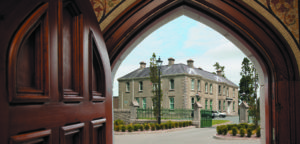EASTER SUNDAY – 12 APRIL 1998
HOMILY BY CARDINAL SEÁN BRADY
ST. PATRICK’S CATHEDRAL, ARMAGH
Why look among the dead for someone who is alive? It was the women who had prepared the spices to anoint the body of Jesus, it was they who were up at the first sign of dawn and went to the tomb where Jesus had been buried. They had been so saddened and shocked by his death, the death of Jesus whom they loved, that they could not wait one minute longer. They had to be on their way to perform this last labour of love, the anointing of his dead body.
They were stunned to find the stone rolled back and the tomb empty. They were terrified when two men in brilliant clothes appeared at their side and asked the question:
“Why look among the dead for someone who is alive?”
Jesus is no longer dead, he has risen, on the third day, as he said he would. So, Mary of Magdala, Joanna and Mary, the mother of James, those three valiant women become the first people to hear the fantastic news – ‘He is not here – he has risen’.
They had known Jesus in Galilee, their home country. They had got to know him and love him very dearly. They wanted to show their love for him in death as well as in life. Their love and loyalty are rewarded with this wonderful revelation – He is not here – he has risen.
The women were asked to remember what Jesus had said – that he would be handed over into the power of sinful men and be crucified – but that he would rise from the dead. Then they remembered his words.
Of course when the women came back and told the eleven Apostles, Peter, James and John and the rest what happened? Nobody believed them. This story was pure nonsense. In time the eleven Apostles changed their opinions, especially after Peter ran to the tomb and saw for himself and came away amazed at what had happened. It all just goes to show that even saints, future saints, can have moments of doubt and disbelief.
It seems to me that we can draw a number of important conclusions from this. The Risen Christ is alive today. He is not to be found among the dead. The disciples spent the rest of their lives discovering the fact that Jesus was indeed alive and in their midst, in new ways. Jesus didn’t leave them but he remained present. The body of Christ was found in new and different ways. Peter for example discovered that God has no favourites but in every country anyone who is God-fearing and does what is right, is acceptable to God. The body of Christ is therefore to be found in all of humanity, not merely in some part of the human family. Remember it was their love for Christ which brought those three women to the tomb and caused them to be chosen as the first witnesses of the Resurrection.
Yes, Jesus Christ is alive. It is important that we meet him, that we find him, that we get in contact with him, that we are united with him. Otherwise the greeting – Happy Easter – is going to sound very hollow indeed.
What do we mean by Happy Easter? Is it something just like a material feast for self-enjoyment or is it some discovery of the joy of what Jesus has done for us, of what Jesus has achieved for us?
Yesterday I met someone who is a Chaplain in a hospital. She told me that she often gives God thanks for all the wonderful people she had assisted in their dying moments over the last years. She was praying that they were now seeing God face to face since they had helped her to see Jesus here on Earth.
You see we often seem to preach a Christ who may be alive, yes, but who seems to have vanished and left no traces behind. We seem to be describing nothing more than a historical event which happened once upon a time.
If our faith is about something that happened long ago and nothing more, about someone who lived in bygone days but does not impinge on our lives, then that faith is no more than a belief in something that happened 2000 years ago. It is a belief in a historical fact, it is not a belief in a living person. Our faith should be that and it should be much more. Easter calls us to believe that Christ is alive and active and present and loving and helping in our lives.
That is the way the early Christians experienced Jesus in their lives and in their midst. Peter describes how Jesus appeared and ate and drank with them after he arose from the dead. But do you ever get the impression that for us today there is no direct encounter with the Risen Lord? Yes, we sing ‘Jesus Christ is risen today’, but really mean ‘Jesus Christ was risen once upon a time’.
We call upon people to put their faith in Jesus. We are asking them to believe that the Bible story is true. Where has Jesus gone? How can you and I have our own meeting with Jesus and come to know him directly, the Risen Christ and experience his power and his love in our lives?
Yes, we do meet Jesus in Holy Communion – we receive his Body and Blood in the Blessed Sacrament. We meet the Risen Christ most powerfully when we turn to him in prayer and pour out all our troubles to him. We meet him most mercifully when we come to Confession to get rid of our burden of guilt and shame. We can hear him speak to us most pertinently as we read and listen to his Holy Scriptures. We meet him in his body, the body of Christ, the Church.
The fact is that what happened to all of us at Baptism tells us where Jesus is to be found. At Baptism we shared in his death and in his victory over sins. We became his brothers and sisters, we became part of his body – the Church – he is to be found there.
Yes, the Lord’s body is no longer in the tomb. Where have they laid it? They have laid it right here in the world, in this city, in the middle of this congregation. We see the Risen Christ all around us, in the eyes and faces of those sitting beside us, in the bread and wine on the altar, and in the people we meet every day of the year. Yes, Christ is risen for sure. “They have taken the Lord out of the tomb and we do not know where they put him”, Mary Magdalene said to Jesus, not knowing that she was actually speaking to him.
The fact is that nobody actually found Jesus where they expected to find him on that first Easter morning, at the tomb. They found him alive, in the middle of them, in their midst, walking along by their sides, explaining the Scriptures, still bearing the scars of his passionate love for us.
What was said to the women at the tomb is still true: “Remember what he said to you” One of the things he said was:
“Whatever you do to one of these, the smallest of my brothers and sisters, you do to me”.
Christ is Risen indeed. His body walks the earth today healing, teaching, feeding, suffering, dying, and rising. You and I and all of the human race, are the living answers to the question which Mary of Magdalene asked implicitly when she said: “They have taken the body of my Lord and we do not know where they have put him”. Yes the Lord is taken from his tomb and placed in the centre of his world. Let us rejoice and be glad.
Those amazing women who stood beneath the Cross to the bitter end represent that part of the Church which loves. They are in every parish and in every age. People who have come to see in the experience of their own lives the hand of God at work in their lives. The plan of God at work in their lives. And they decide to respond to that love in their own lives. They had prepared their spices to anoint the body of Jesus and so do all they possibly could to protect it from corruption. It is amazing that they weren’t deterred or disheartened by the terrible events of Thursday and Friday. They obviously hadn’t given too much thought to the practicalities of what they proposed to do. Who was going to roll back the huge stone for them from the mouth of the tomb? Nevertheless their faithful devotion takes them on their way. And God rewards their faith. The obstacles were eliminated, the stone was already rolled back and at the end of the journey, they entered the tomb, remember the tomb was in the form of a vault. The angel knows what they are looking for, Jesus of Nazareth, who had died on the cross two days before.
“See for yourselves” the angel tells them “There is the place. Go tell the disciples, you will find him in Galilee as he told you”. Galilee was home, that was where it all began. It is his country, its your country, its my country. We will all find the Risen Christ where we live our ordinary lives. Those women must go back to Galilee, “They must go to Galilee”, Christ had said: ‘They will see me there”.
In Galilee it all began in the reality of their daily lives. There Jesus first found them as they went about their daily work whether it was as fishermen or civil servants or farmers. There the new life must all begin, the life of finding the Risen Christ begins for you or for me in our daily life.
At Easter we celebrate Christ’s victory over sin and death. We celebrate the birth of new life. For all Christians it is a time of profound hope. The hope of new life grows strong here in this part of the world this Eastertide. We have an extra motive for celebration with the good news that those involved in the peace talks have reached agreement.
I congratulate all those involved in the negotiations. I thank God that the prayers of so many people for the peacemakers and for a successful outcome to these talks has been answered. Now people begin to hope again that the agreement which has been reached will be a significant milestone on the road to a just and lasting peace. The proposals it contains should be given a fair hearing so that they may lead the way to an Ireland where people grow in respect for each other and learn to trust each other and live with each other despite their differences.
Only a limited number of people was involved in the peace talks. All of us now must be participants in the work of reconciliation, of building trust and of healing the hurts.
The Easter Feast is about victory over death and the birth of new life. The hope of new life grows stronger this Eastertide. We must pray earnestly this weekend that this hope will sustain us all through the inevitable challenges which lie ahead.



You must be logged in to post a comment.